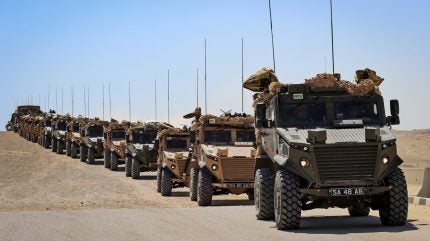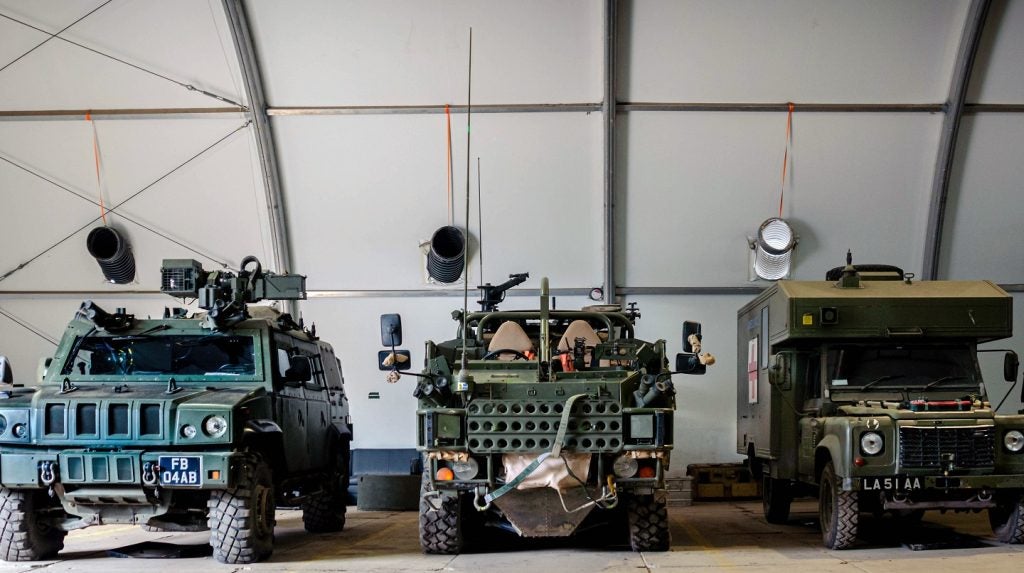
The British Army is still to formally define the scope of the service’s Land Mobility Programme (LMP), with the UK Ministry of Defence (MoD) not due to complete the formal change request until February 2025 ahead of an outline business case at some point between March-October the same year.
Pre-market engagement for the British Army’s LMP is now expected to begin in November 2024, with an engagement day for industry still ‘to be confirmed’ and the subsequent tender and trial not until the 2026 timeframe.
The details emerged during a series of briefings at the DVD 2024 event at UTAC Millbrook in late-September, where British Army officials provided updates into the service’s key land programmes.
A full business case, where the tender selection for demonstration and manufacture is awarded, is not likely until Q4 2026 at the earliest.
These timelines exist only for the Pilot case, likely to be the Medium Protected Mobility effort, which will have a minimum deployable capability within the next five years, around the 2029-2030 timeframe.
Officials stated that priority will be given to platforms that focus mission system modularity, as the British Army is seeking to consolidate its 16 designs currently utilised in the mobility fleet down to around five designs, emphasising commonality.
This could include a military- or commercial-off-the-shelf (MOTS/COTS) solution, with a common support package sought to provide sustainment for the future mobility vehicle fleet.

Industry frustration and challenges persist
Voices from within industry have privately expressed frustration to Army Technology at the delays being experienced with the LMP effort, which was supposed to make a decision on an outline business base in Q1 2024.
The new UK government’s upcoming autumn budget, where it is anticipated that defence programmes could be hit in a bid to partially fill a claimed £22bn ($28.9bn) fiscal shortfall, could have a detrimental impact on the scope and scale of large-scale procurement.
Business confidence has also been impacted by the UK governments persistent public utterings of the dire state of the country’s finances, to the point at which financial institutions have been moved to warn against such gloomy forecasts.
The opposition Conservative Party repudiated the Labour government’s claim of the public funding shortfall, pointing to the UK being the fastest growing economy in the G7 in 2024.
In addition, a new Strategic Defence Review being undertaken by the Labour government, which is only due to deliver its findings in H1 2025 at the earliest, is adding additional uncertainty about the potential direction for the LMP programme.
In data: Land Protected Mobility
The latest understanding of the LMP indicates that the focus is on three Category A sub-programmes, each with its own procurement and approvals process that, in theory, is able to adapt to changing circumstances to optimise acquisitions. The three sub-programmes include: Light Mobility Vehicle (LMV), Light Protected Mobility (Lt PM), and Medium Protected Mobility (Med PM).
According to newly released information, the LMV programme will deliver a platform offering unprotected or lightly protected mobility with a gross vehicle mass (GVM) of around 3,500kg, and be operable by the joint force of the British Army, Royal Air Force, Royal Navy/Royal Marines, Strategic Command.
Both the Lt PM and Med PM are intended to provide high mobility platforms that ‘build on existing capability’, with a GVM of 10,000kg and 20,000kg respectively. However, while the Lt PM would be operable by the Joint Force, the Med PM would only service the British Army.
Earlier information presented by the British Army in 2023 saw four main categories of platforms being sought – Heavy (~500 vehicles), Medium (~2000 vehicles), Light (~2500 vehicles), and Utility (~3000 vehicles) – for a potential total of around 8,000 vehicles.
The latest data did not include a Heavy requirement, which had a GVM in the 40,000kg weight category.

Speaking at an LMP briefing at DSEI 2023, British Army officials said that in-service platforms that will be part of this LMP consolidation effort include the Wolfhound, Mastiff, and Ridgeback protected mobility platforms, the Panther and Foxhound 4x4s, the tracked Bulldog FV430, as well as utility platforms such as the Coyote, Jackal, Land Rover, and Pinzgauer.
At the time, Brigadier Matthew Wilkinson, vehicle support team leader, at the MoD’s Defence Equipment & Support, said the British Army had “inherited a mixed fleet of vehicles”, which would have to be consolidated.
Acquisition strategy would also see a shift away from the purchase of “monolithic blocks” of vehicles to “packages”, filling a requirement where needed. In addition, platforms competing for LMP requirements should have a “60% or greater” UK footprint, further emphasising a leading narrative emerging across the UK defence sector.
The programme does not include acquisitions being sought under the Light Tactical Mobility Platform (LTMP) Medium and LTMP Light programme, through which the MoD is currently seeking industry responses to the potential purchase of more than 1,000 4×4 and all-terrain vehicles, valued at a combined total of £91.3m.





